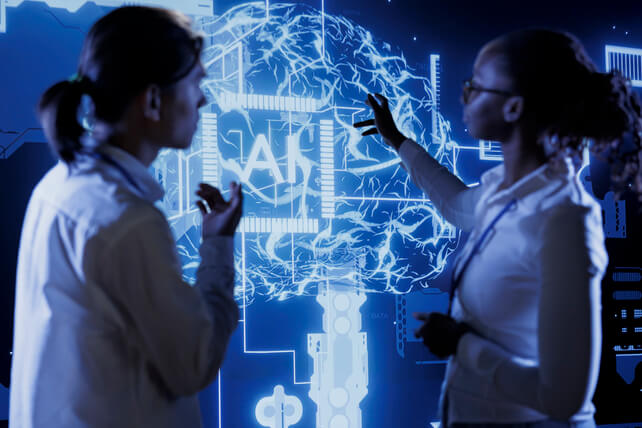Introduction: The Evolution of Online Exam Monitoring
As education and certification have shifted to digital platforms, ensuring the integrity of online assessments has become a top priority. Traditional proctoring methods, such as live human invigilation, often pose logistical challenges, high costs, and privacy concerns. This has paved the way for a new solution: AI-powered proctoring.
AI-powered proctoring uses artificial intelligence technologies to monitor and evaluate student behavior during an online test. It automates the process of detecting cheating and ensures that test-takers follow the rules—without the constant oversight of human proctors. But how exactly does it work? What are its advantages and challenges? This guide explores AI-powered proctoring in detail, including its core technologies, benefits, limitations, and real-world applications.
What Is AI-Powered Proctoring?
AI-powered proctoring is a technology-driven method of supervising online exams using artificial intelligence. Instead of relying on a human to watch students throughout the exam, AI software analyzes behavior patterns, environmental cues, and audio/video feeds to flag suspicious activities.
AI proctoring systems can:
- Verify a student’s identity using facial recognition
- Monitor head, eye, and body movements
- Track screen activity and keystrokes
- Detect multiple people in the camera view
- Record audio for background noise analysis
The flagged incidents are then reviewed by human proctors or instructors after the test, enabling scalable and consistent monitoring for large groups of examinees.
Types of AI-Powered Proctoring
AI proctoring can be categorized into different types depending on the level of supervision and automation:
1. Automated Proctoring
This type is fully managed by AI. It monitors students using webcam, screen recording, and microphone feeds without any human involvement during the exam. AI algorithms flag suspicious behavior for later review.
2. Live Remote Proctoring with AI Assistance
Here, a human proctor watches candidates in real time, supported by AI alerts. The system highlights questionable activity so the proctor can intervene immediately.
3. Record-and-Review Proctoring
The exam session is recorded, and AI tools highlight segments where violations might have occurred. These flagged sections are later reviewed by human proctors.
How Does AI Proctoring Work?
AI-powered proctoring solutions typically follow a multi-step process to ensure test integrity:
Step 1: Identity Verification
Before the exam starts, the system verifies the candidate’s identity through facial recognition, ID scanning, and biometric analysis to ensure that the right person is taking the test.
Step 2: Environment Scanning
The candidate is asked to scan their surroundings with their webcam. The AI checks for additional devices, people, or materials that may compromise the exam’s integrity.
Step 3: Real-Time Monitoring
Throughout the test, the AI continuously monitors:
- Face and eye movements (to detect if the student is looking away too often)
- Presence of unauthorized devices (like phones or tablets)
- Audio cues (such as whispered conversations)
- Browser activity (like switching tabs)
Step 4: Behavior Analysis
AI uses pattern recognition to assess normal vs. suspicious behavior. For instance, excessive head movement, repetitive background noises, or presence of multiple faces may be flagged.
Step 5: Reporting
Post-exam, the system generates a comprehensive report detailing:
- Timeline of the exam
- Summary of flagged incidents
- Confidence level of AI detections
- Recorded evidence (video/audio/screenshots)
This report is reviewed by instructors or exam authorities for final decision-making.
Key Technologies Behind AI Proctoring
AI-powered proctoring relies on several advanced technologies working together:
1. Facial Recognition
Used to verify identity and monitor continuous presence during the test. It can detect impersonation or student absence.
2. Computer Vision
Enables the system to interpret camera footage, detect eye movements, identify prohibited materials, and recognize changes in the environment.
3. Machine Learning
Trains the AI to distinguish between normal and abnormal test-taking behaviors. It gets better over time by learning from new data sets and flagged incidents.
4. Natural Language Processing (NLP)
Used to analyze audio input, decipher speech patterns, and detect potential coaching or background conversations.
5. Keystroke Dynamics
Monitors typing behavior to confirm identity and assess for unusual input methods (like pasted answers or irregular typing speed).
Benefits of AI-Powered Proctoring
AI-based exam monitoring offers numerous advantages for institutions, instructors, and students:
✅ Scalability
AI proctoring can accommodate thousands of test-takers simultaneously without the need for hundreds of human invigilators.
✅ Cost Efficiency
Reduces the expenses associated with hiring, training, and managing live proctors.
✅ Consistency
AI ensures uniform enforcement of exam rules, reducing human bias or oversight.
✅ Flexibility
Students can take tests from any location, eliminating the need for physical testing centers.
✅ Faster Results
With instant flagging and automated reporting, educators can quickly review incidents and make decisions.
Challenges and Concerns
While AI-powered proctoring offers compelling advantages, it also comes with challenges:
❌ Privacy Issues
Recording students in their personal environments raises questions about data privacy and consent.
❌ Bias in Algorithms
Facial recognition tools have been criticized for accuracy disparities across different genders and ethnicities.
❌ False Positives
AI may flag innocent behaviors as suspicious—like looking around while thinking or background noises from roommates.
❌ Technical Glitches
Poor internet connectivity, low-quality webcams, or system crashes can lead to false alerts or failed exams.
❌ Student Anxiety
Knowing they are being monitored by AI may increase test anxiety, potentially impacting performance.
Best Practices for Using AI Proctoring
To implement AI-powered proctoring ethically and effectively, institutions should:
- Communicate Transparently: Inform students how their data is collected, used, and stored.
- Offer Consent-Based Testing: Allow students to opt out or choose alternative testing methods where possible.
- Train Instructors: Help educators interpret AI reports and understand the limitations of automation.
- Use Hybrid Models: Combine AI and human oversight for balanced monitoring.
- Conduct Bias Audits: Regularly review algorithms for performance disparities and accuracy issues.
Use Cases Across Industries
AI-powered proctoring isn’t limited to academic institutions. It’s now widely adopted across various sectors:
Education
Universities and colleges use AI proctoring for entrance exams, course assessments, and certifications.
Online Course Platforms
MOOCs like Coursera and edX integrate proctoring to uphold the credibility of their certifications.
Corporate Training
Enterprises use AI tools for compliance tests, skill assessments, and employee certifications.
Healthcare & Legal Exams
Licensing boards use AI proctoring to maintain exam integrity in fields like nursing, pharmacy, and law.
Top AI Proctoring Tools
Here are a few widely used AI-powered proctoring platforms:
| Platform | Key Features | Best For |
| ProctorU | Live + AI, ID verification, analytics | Higher education institutions |
| Honorlock | AI flags + live proctor intervention | Online course providers |
| Mercer Mettl | Facial tracking, browser lockdown, secure tests | Corporate and government exams |
| Respondus Monitor | LMS integration, webcam monitoring | Universities using LMS platforms |
| Talview Proctoring | Face tracking, speech detection, keystroke biometrics | Skill-based assessments in HR |
The Future of AI-Powered Proctoring
As the demand for remote testing continues to rise, AI proctoring is likely to evolve in several key areas:
- Greater Personalization: Adaptive proctoring settings based on individual risk profiles.
- Improved Accuracy: Enhanced machine learning models to reduce false positives and increase fairness.
- Increased Transparency: Tools that allow test-takers to see their flagged behaviors and appeal decisions.
- Stronger Security Protocols: Blockchain-based credentialing and tamper-proof testing environments.
We may also see AI proctoring systems integrate more deeply into LMS platforms, making setup seamless and minimizing disruption.
Final Thoughts
AI-powered proctoring has redefined how we approach online exam integrity. While it’s not a perfect solution, it offers scalability, consistency, and security that traditional proctoring often lacks. To unlock its full potential, institutions must implement it thoughtfully—balancing automation with ethics, and security with sensitivity to privacy and inclusivity.
For students, understanding how these systems work can reduce anxiety and build trust. For educators and organizations, AI-powered proctoring represents a promising future where assessments can be both secure and accessible from anywhere in the world.











